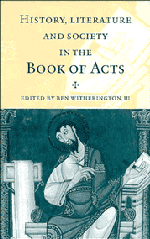Book contents
- Frontmatter
- Contents
- Preface
- PART I ISSUES OF GENRE AND HISTORICAL METHOD
- PART II HISTORICAL AND THEOLOGICAL DIFFICULTIES IN ACTS
- PART III ISSUES OF LITERARY CRITICISM
- 11 Internal repetition in Luke–Acts: contemporary narratology and Lucan historiography
- 12 Luke's characterizing use of the Old Testament in the Book of Acts
- 13 Editing the Good News: some synoptic lessons for the study of Acts
- 14 The means of absent ends
- Index of biblical references
13 - Editing the Good News: some synoptic lessons for the study of Acts
Published online by Cambridge University Press: 02 February 2010
- Frontmatter
- Contents
- Preface
- PART I ISSUES OF GENRE AND HISTORICAL METHOD
- PART II HISTORICAL AND THEOLOGICAL DIFFICULTIES IN ACTS
- PART III ISSUES OF LITERARY CRITICISM
- 11 Internal repetition in Luke–Acts: contemporary narratology and Lucan historiography
- 12 Luke's characterizing use of the Old Testament in the Book of Acts
- 13 Editing the Good News: some synoptic lessons for the study of Acts
- 14 The means of absent ends
- Index of biblical references
Summary
Perhaps it is a result of the canonical division of Luke–Acts, or perhaps it has been caused by the over-compartmentalization of NT studies in the guild, but whatever the cause, the study of Luke's use of sources in Acts has tended to be treated differently than his use of sources in his Gospel, especially in regard to the speeches in Acts. This, I am convinced, is a mistake, for several good reasons.
First, the prologue to the Gospel (Lk. 1.1– 4) and the first verse of Acts (1.1) make rather clear that the author considers the book we call Acts as the continuation of, or second volume of, his narrative. Second, the detailed study of R. C. Tannehill has shown that a good case can be made for the general narrative unity of Luke–Acts. Third, C. H. Talbert has shown that the two volumes have certain structural similarities, for instance paradigmatic speeches in Luke 4 and Acts 2 presage the drama that follows. Fourth, D. Juel has shown that even beyond the level of literary patterns, there is a thematic unity between Luke and Acts. Fifth, G. Liidemann has argued persuasively that a comparison of Acts with some material in Paul's letters (for example Acts 18 and 1 and 2 Corinthians), makes clear that Luke is most definitely drawing on various traditions in Acts, as he did in his first volume.
- Type
- Chapter
- Information
- History, Literature, and Society in the Book of Acts , pp. 324 - 347Publisher: Cambridge University PressPrint publication year: 1996
- 4
- Cited by



